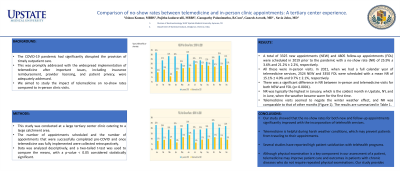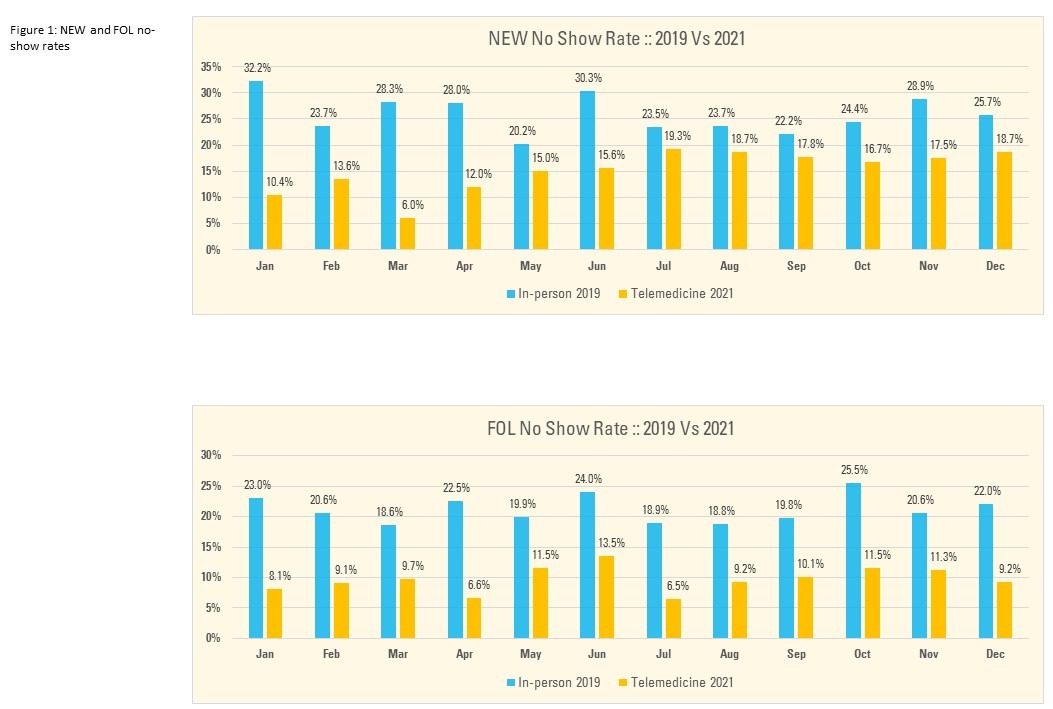Tuesday Poster Session
Category: Practice Management
P4064 - Comparison of No-Show Rates Between Telemedicine and In-Person Clinic Appointments: A Tertiary Center Experience
Tuesday, October 24, 2023
10:30 AM - 4:00 PM PT
Location: Exhibit Hall

Has Audio
- VK
Vishnu Kumar, MBBS
SUNY Upstate Medical University
Syracuse, New York
Presenting Author(s)
Vishnu Kumar, MBBS1, Pujitha kudaravalli, MBBS1, Ganapathy Palanimuthu, 2, Ganesh Aswath, MD3, Savio John, MD1
1SUNY Upstate Medical University, Syracuse, NY; 2OneGlance, Syracuse, NY; 3Upstate University Hospital, Syracuse, NY
Introduction: The COVID-19 pandemic had significantly disrupted the provision of timely outpatient care. This was promptly addressed with the widespread implementation of telemedicine after important issues, including insurance reimbursement, provider licensing, and patient privacy, were adequately addressed. We aimed to study the impact of telemedicine on no-show rates compared to in-person clinic visits.
Methods: This study was conducted at a large tertiary center clinic catering to a large catchment area. The number of appointments scheduled and the number of appointments that were successfully completed pre-COVID and once telemedicine was fully implemented were collected retrospectively. Data was analyzed descriptively, and a two-tailed t-test was used to compare the means, with a p-value < 0.05 considered statistically significant.
Results: A total of 3325 new appointments (NEW) and 4805 follow-up appointments (FOL) were scheduled in 2019 prior to the pandemic with a no-show rate (NR) of 25.9% ± 3.6% and 21.2% ± 2.2%, respectively. All these were in-person visits. In 2021, when we had a full calendar year of telemedicine services, 2524 NEW and 3350 FOL were scheduled with a mean NR of 15.1% ± 4.0% and 9.7% ± 2.1%, respectively. There was a significant difference in NR between in-person and telemedicine visits for both NEW and FOL (p< 0.0001). NR was typically the highest in January, which is the coldest month in Upstate, NY, and in June, when the weather became warm for the first time. Telemedicine visits seemed to negate the winter weather effect, and NR was comparable to that of other months (Figure 1). The results are summarized in Table 1.
Discussion: Our study showed that the no-show rates for both new and follow-up appointments significantly improved with the incorporation of telehealth services. Telemedicine is helpful during harsh weather conditions, which may prevent patients from traveling to their appointments. Several studies have reported high patient satisfaction with telehealth programs. Although physical examination is a key component in our assessment of a patient, telemedicine may improve patient care and outcomes in patients with chronic diseases who do not require repeated physical examinations. Our study provides further evidence that telemedicine should be routinely incorporated into the healthcare system, particularly for outpatient care.

Disclosures:
Vishnu Kumar, MBBS1, Pujitha kudaravalli, MBBS1, Ganapathy Palanimuthu, 2, Ganesh Aswath, MD3, Savio John, MD1. P4064 - Comparison of No-Show Rates Between Telemedicine and In-Person Clinic Appointments: A Tertiary Center Experience, ACG 2023 Annual Scientific Meeting Abstracts. Vancouver, BC, Canada: American College of Gastroenterology.
1SUNY Upstate Medical University, Syracuse, NY; 2OneGlance, Syracuse, NY; 3Upstate University Hospital, Syracuse, NY
Introduction: The COVID-19 pandemic had significantly disrupted the provision of timely outpatient care. This was promptly addressed with the widespread implementation of telemedicine after important issues, including insurance reimbursement, provider licensing, and patient privacy, were adequately addressed. We aimed to study the impact of telemedicine on no-show rates compared to in-person clinic visits.
Methods: This study was conducted at a large tertiary center clinic catering to a large catchment area. The number of appointments scheduled and the number of appointments that were successfully completed pre-COVID and once telemedicine was fully implemented were collected retrospectively. Data was analyzed descriptively, and a two-tailed t-test was used to compare the means, with a p-value < 0.05 considered statistically significant.
Results: A total of 3325 new appointments (NEW) and 4805 follow-up appointments (FOL) were scheduled in 2019 prior to the pandemic with a no-show rate (NR) of 25.9% ± 3.6% and 21.2% ± 2.2%, respectively. All these were in-person visits. In 2021, when we had a full calendar year of telemedicine services, 2524 NEW and 3350 FOL were scheduled with a mean NR of 15.1% ± 4.0% and 9.7% ± 2.1%, respectively. There was a significant difference in NR between in-person and telemedicine visits for both NEW and FOL (p< 0.0001). NR was typically the highest in January, which is the coldest month in Upstate, NY, and in June, when the weather became warm for the first time. Telemedicine visits seemed to negate the winter weather effect, and NR was comparable to that of other months (Figure 1). The results are summarized in Table 1.
Discussion: Our study showed that the no-show rates for both new and follow-up appointments significantly improved with the incorporation of telehealth services. Telemedicine is helpful during harsh weather conditions, which may prevent patients from traveling to their appointments. Several studies have reported high patient satisfaction with telehealth programs. Although physical examination is a key component in our assessment of a patient, telemedicine may improve patient care and outcomes in patients with chronic diseases who do not require repeated physical examinations. Our study provides further evidence that telemedicine should be routinely incorporated into the healthcare system, particularly for outpatient care.

Figure: Image 1
Disclosures:
Vishnu Kumar indicated no relevant financial relationships.
Pujitha kudaravalli indicated no relevant financial relationships.
Ganapathy Palanimuthu indicated no relevant financial relationships.
Ganesh Aswath indicated no relevant financial relationships.
Savio John indicated no relevant financial relationships.
Vishnu Kumar, MBBS1, Pujitha kudaravalli, MBBS1, Ganapathy Palanimuthu, 2, Ganesh Aswath, MD3, Savio John, MD1. P4064 - Comparison of No-Show Rates Between Telemedicine and In-Person Clinic Appointments: A Tertiary Center Experience, ACG 2023 Annual Scientific Meeting Abstracts. Vancouver, BC, Canada: American College of Gastroenterology.
